
The Solar-Terrestrial Centre of Excellence (STCE) is a collaborative network of the Belgian Institute for Space Aeronomy, the Royal Observatory of Belgium and the Royal Meteorological Institute of Belgium.
 |
Published by the STCE - this issue : 7 Aug 2014. The Solar-Terrestrial Centre of Excellence (STCE) is a collaborative network of the Belgian Institute for Space Aeronomy, the Royal Observatory of Belgium and the Royal Meteorological Institute of Belgium. |
| Archive of the newsletters | Subscribe to this newsletter by mail |
Solar filaments are clouds of ionized gas above the solar surface squeezed between magnetic regions of opposite polarity. Being cooler and denser than the plasma underneath and their surroundings, these magnetic borderlines appear as dark lines when seen on the solar disk using special filters. As filaments grow longer, they are more likely to erupt, often accompanied by a coronal mass ejection (CME).
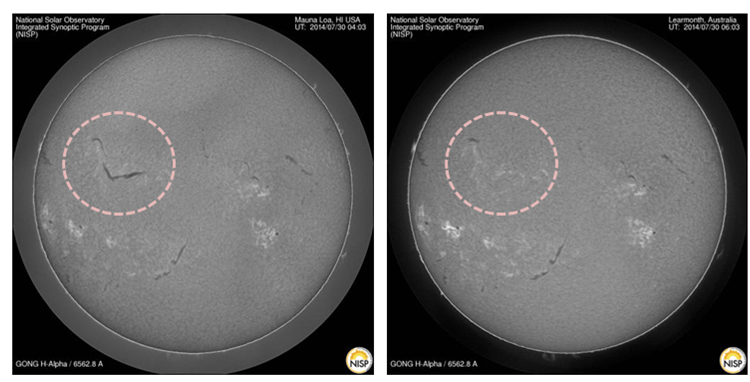
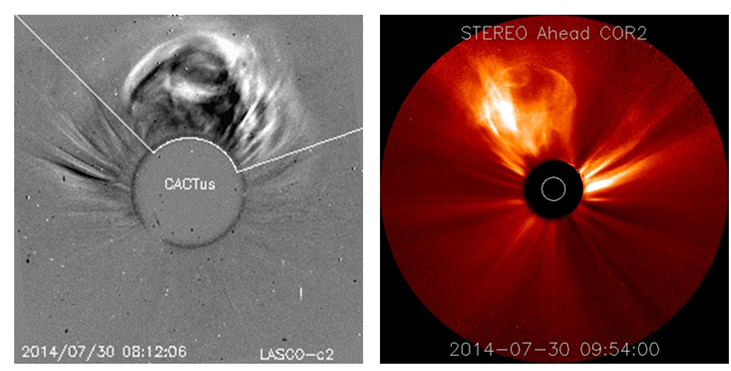
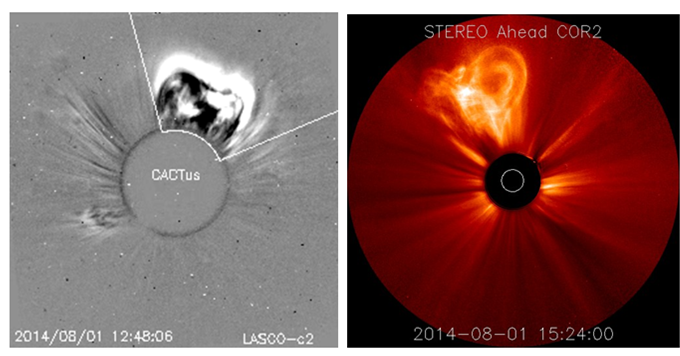
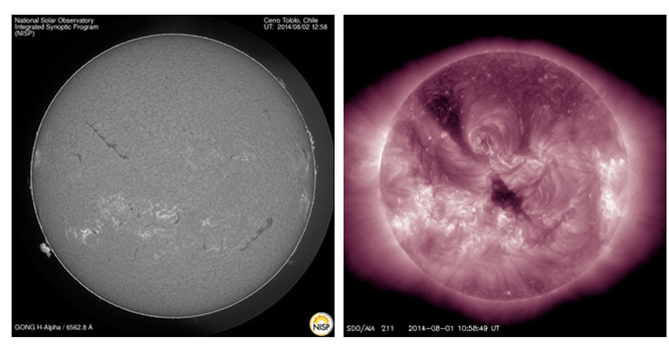
Credits - Image and data were taken from the GONG H-alpha Network (http://halpha.nso.edu/), SOHO (http://sohowww.nascom.nasa.gov/), STEREO (http://stereo.gsfc.nasa.gov/), SDO (http://sdo.gsfc.nasa.gov/), CACTUS (http://www.sidc.oma.be/cactus/) and Helioviewer (http://helioviewer.org/).
The beginning of the week continued the return of a cluster of active regions on the southern hemisphere that was also present a solar rotation ago. See the comparison underneath (left image: 30 July, right image: 3 July).
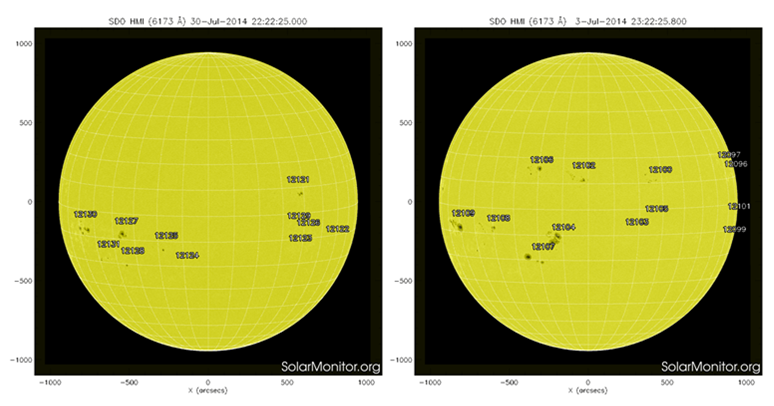
A total of 34 C- and 3 M-class flares were observed, two thirds of which were produced by sunspot regions NOAA 2127, 2130 and 2132. NOAA 2127 produced an M1 flare on 1 August, and NOAA 2130 was the source of 14 C-class and 2 M-class flares, including the strongest event of the week (M2.5 peaking on 31 July at 11:14UT) and an M2 flare on 1 August. The bulk of the coronal mass ejection (CME) associated to the 1 August M-class flaring was directed to the southeast and away from Earth.
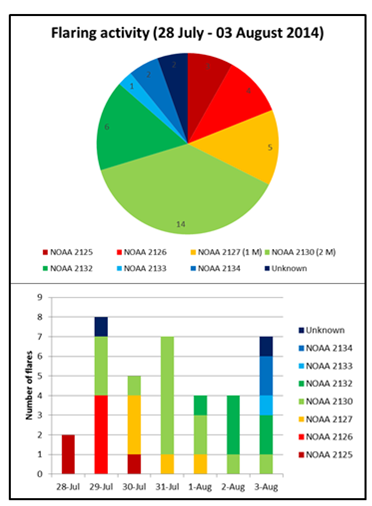
A 30 degrees long filament erupted around 04:30UT on 30 July in the northeast solar quadrant. Coronagraphic imagery indicated a possible glancing blow from the associated CME on 2 August. The same filament channel was the source of another filament eruption on 1 August (around 10:15UT). However, the associated CME was directed mainly to the north and did not seem to have an Earth-directed component despite its proximity to the disk's center.
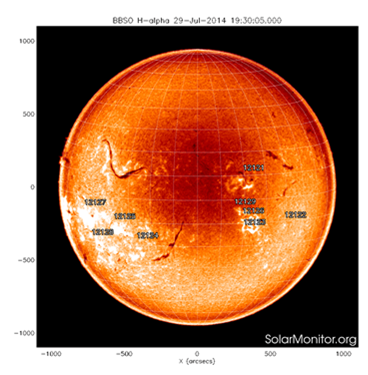
Two 25-30 degrees long filaments in the northeast and southwest quadrant remained stable. A small equatorial coronal hole (CH) with positive magnetic polarity passed the central meridian (CM) on 1 August.
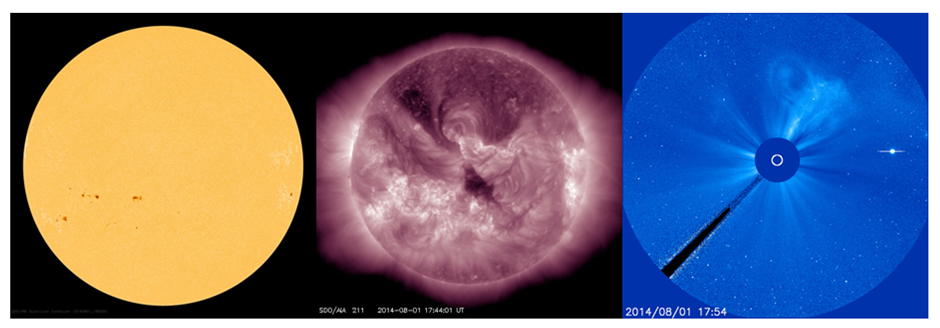
A movie of the solar activity in white light (sunspot groups), EUV (coronal holes, flares, and filament eruptions), and coronagraphic images (CMEs) can be seen at http://youtu.be/fVLY_Mp1ELU
| DAY | BEGIN | MAX | END | LOC | XRAY | OP | 10CM | TYPE | Cat | NOAA |
| 31 | 1101 | 1114 | 1121 | M2.5 | 35 | 2130 | ||||
| 01 | 1443 | 1448 | 1457 | M2.0 | 340 | III/1 | 35 | 2130 | ||
| 01 | 1755 | 1813 | 1848 | M1.5 | 97 | III/2CTM/1II/2IV/1 | 32 | 2127 |
| LOC: approximate heliographic location | TYPE: radio burst type |
| XRAY: X-ray flare class | Cat: Catania sunspot group number |
| OP: optical flare class | NOAA: NOAA active region number |
| 10CM: peak 10 cm radio flux |
Solar flare activity fluctuated between low and moderate during the week.
In order to view the activity of this week in more detail, we suggest to go to the following website from which all the daily (normal and difference) movies can be accessed: http://proba2.oma.be/ssa
This page also lists the recorded flaring events.
A weekly overview movie can be found here (SWAP week 227).
http://proba2.oma.be/swap/data/mpg/movies/WeeklyReportMovies/WR197_Dec30_Jan5/weekly_movie_2013_12_30.mp4
Details about some of this week's events, can be found further below.
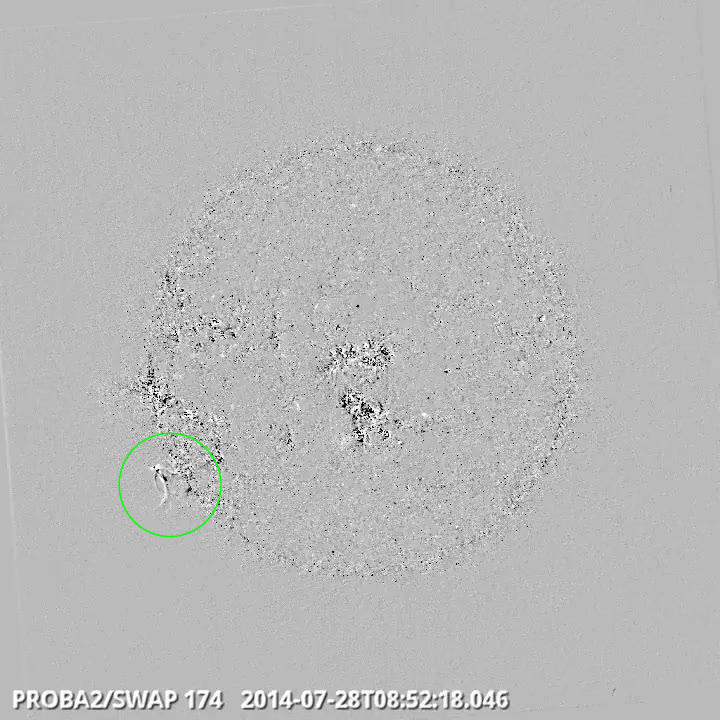
Eruption on the east limb @ 08:52 SWAP difference image
Find a movie of the events here (SWAP difference movie)
http://proba2.oma.be/swap/data/mpg/movies/20140728_swap_diff.mp4
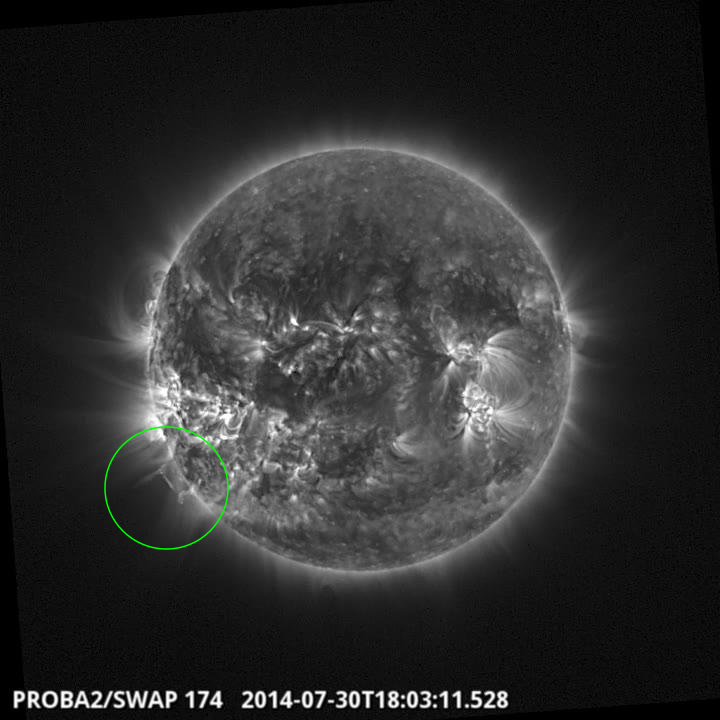
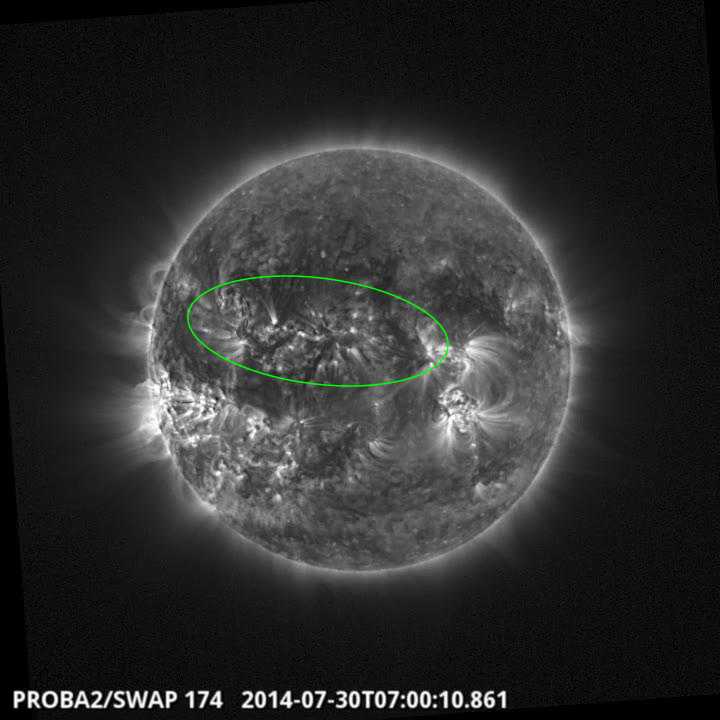
Failed eruption on the east limb @ 18:03 SWAP image
Find a movie of the event here (SWAP movie)
http://proba2.oma.be/swap/data/mpg/movies/20140730_swap_movie.mp4
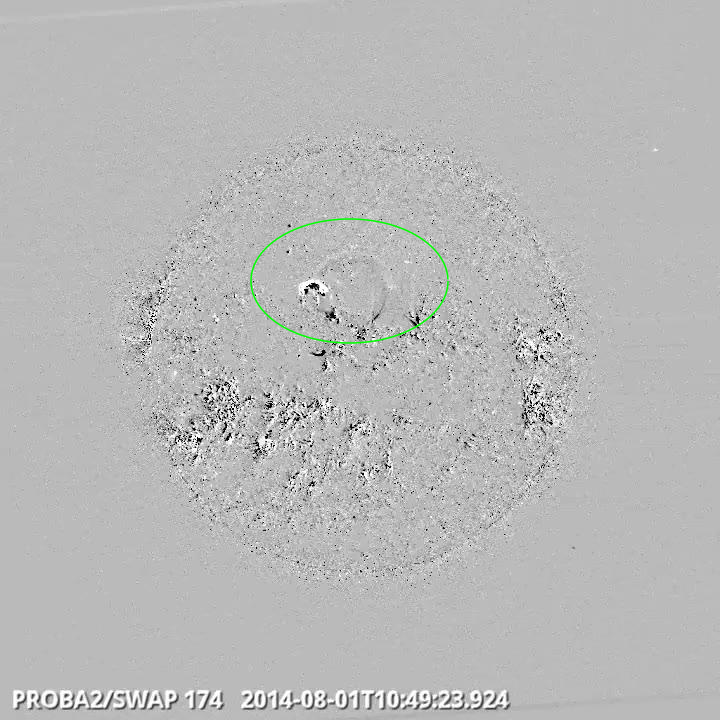
Eruption and arcade loops in the centre @ 10:49 SWAP difference image
Find a movie of the event here (SWAP difference movie)
http://proba2.oma.be/swap/data/mpg/movies/20140801_swap_movie.mp4
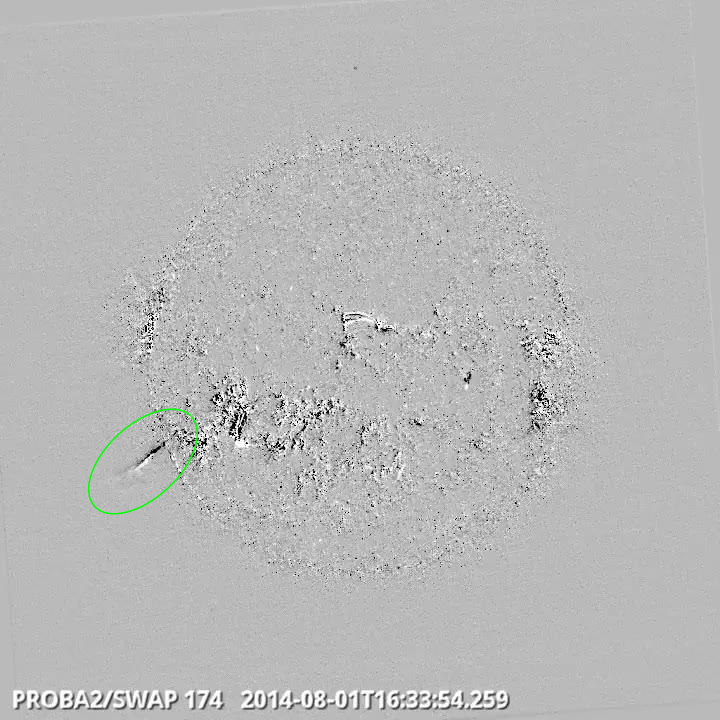
Surge on the east limb @ 16:33 SWAP difference image
Find a movie of the event here (SWAP difference movie)
http://proba2.oma.be/swap/data/mpg/movies/20140801_swap_movie.mp4
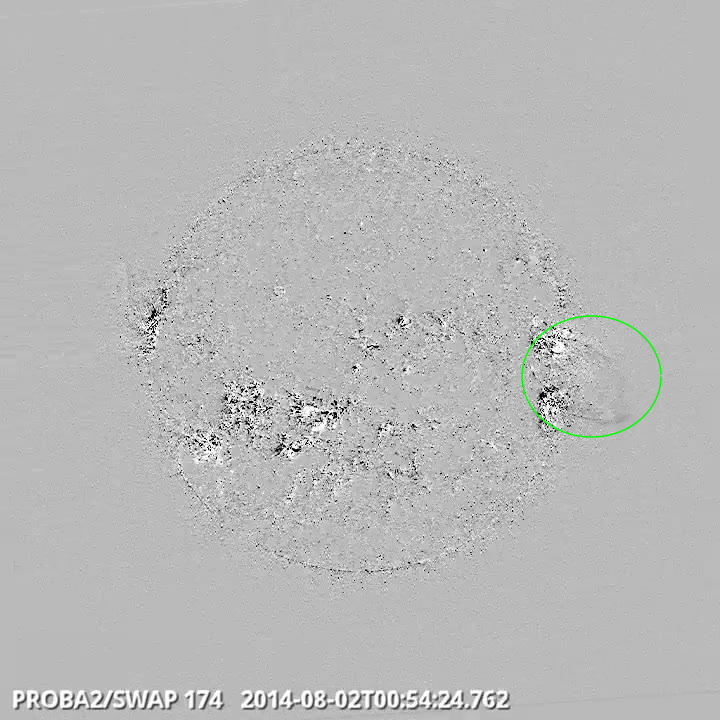
Eruption on the west limb @ 00:54 SWAP difference image
Find a movie of the event here (SWAP difference movie)
http://proba2.oma.be/swap/data/mpg/movies/20140802_swap_movie.mp4
Two sector boundary crossings (SBC) were observed in the solar wind parameters: One early on 28 July, when the direction of the interplanetary field (IMF) changed from away to towards the Sun, and another one on 31 July around noon, when the IMF direction changed again to away from the Sun (see evolution of the Phi angle in graph underneath - blue line). In response to both SBCs, solar wind speed gradually increased resp. from about 330 to about 430 km/s on 28 July, and from about 300 to about 460 km/s on 2 August. Bz varied correspondingly between -8 and +11 nT, and was between -5 and +5 nT in between. Geomagnetic conditions were quiet to unsettled, except shortly after both SBCs when Dourbes recorded a brief active episode on 28 July, and on both 1 and 2 August when a single active period was recorded in the Kp-index (quiet to unsettled conditions in Dourbes).

In the wake of the second SBC, two small disturbances were observed in the solar wind. The first one started on 3 August around 15:00UT, lasted about 6 hours, and may have been related to the late arrival of the 30 July CME, or to the early arrival of the CME associated to the 1 August M-flaring activity. No shock was observed (see evolution of Bz in image above - red line). The second disturbance manifested itself around 19:00UT on 3 August, when wind speed picked up again from about 370 km/s gradually increasing to around 450 km/s late on 4 August. This disturbance possibly marked the influence from the coronal hole that passed the central meridian on 1 August (see graph below). Bz reached maximum negative values of resp. -8 nT, resulting in only unsettled geomagnetic conditions.
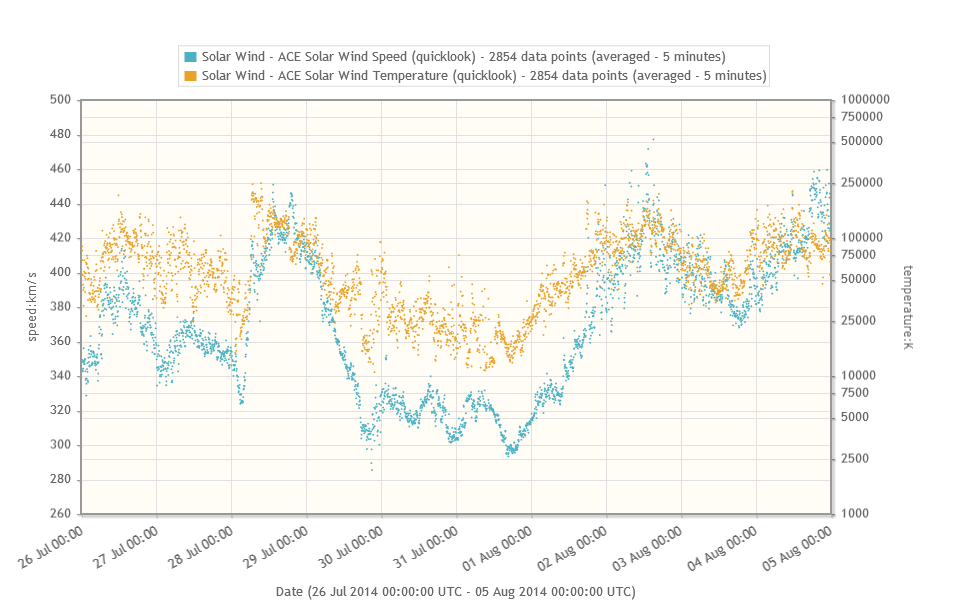
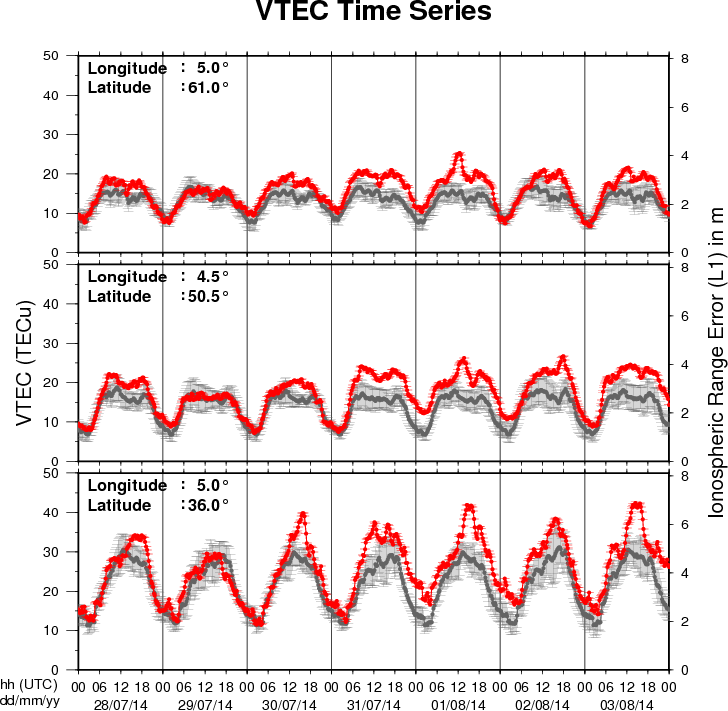
The figure shows the time evolution of the Vertical Total Electron Content (VTEC) (in red) during the last week at three locations:
a) in the northern part of Europe(N61°, 5°E)
b) above Brussels(N50.5°, 4.5°E)
c) in the southern part of Europe(N36°, 5°E)
This figure also shows (in grey) the normal ionospheric behaviour expected based on the median VTEC from the 15 previous days.
The VTEC is expressed in TECu (with TECu=10^16 electrons per square meter) and is directly related to the signal propagation delay due to the ionosphere (in figure: delay on GPS L1 frequency).
The Sun's radiation ionizes the Earth's upper atmosphere, the ionosphere, located from about 60km to 1000km above the Earth's surface.The ionization process in the ionosphere produces ions and free electrons. These electrons perturb the propagation of the GNSS (Global Navigation Satellite System) signals by inducing a so-called ionospheric delay.
See http://stce.be/newsletter/GNSS_final.pdf for some more explanations ; for detailed information, see http://gnss.be/ionosphere_tutorial.php
Start : 2014-09-07 - End : 2014-09-12
Planetary space weather can be characterised by changes in the
ambient planetary magnetic field and plasma populations around the
planetary environment while space climate refers to the long-term
changes in space weather conditions. Space weather and space
climate are driven by the changes in the Sun. The effects of Space
Weather on the Earth's environment are well documented,
particularly in terms of risk to satellites, communications and
ground-based systems such as electrical power grids and pipelines.
However, planetary space weather and space climate studies as well
as better prediction models for space weather are needed. Typically
differences in the magnetic field and plasma environment at
different planets, as well as the distance of the planet from the
sun drives different space weather effects as we move through the
solar system. The use of solar wind propagation models combined
with solar observations allows us to obtain and predict the
interplanetary conditions around each planet.
We solicit papers on planetary as well as terrestrial space
weather and space climate, where data from past and on-going space
missions such as ACE, SOHO, SDO, MEX, VEX, MESSENGER and CASSINI is
used. We welcome papers on observations as well as modeling of
space weather and space climate in our solar system.
Website:
http://meetingorganizer.copernicus.org/EPSC2014/session/16809
Start : 2014-09-09 - End : 2014-09-11
The Workshop on Radiation Monitoring for the International Space
Station (WRMISS) has been held annually since 1996. The major
purpose of WRMISS is to provide a forum for discussion of technical
issues concerning radiation dosimetry aboard the International
Space Station and other spacecraft. This includes discussion of new
results, improved instrumentation, detector calibration, and
radiation environment and transport models. The goal of WRMISS is
to enhance international efforts to provide the best information on
the space radiation environment in low-Earth orbit and on the
exposure of astronauts and cosmonauts in order to optimize the
radiation safety of space crew.
Website:
http://www.ifj.edu.pl/conf/wrmiss/
Start : 2014-09-15 - End : 2014-09-20
The 'Geospace Revisited' conference aims at revisiting
long-standing issues of geospace dynamic phenomena. New data from
space missions like Cluster, THEMIS and the more recent Van Allen
Probes, along with measurements from ground-based magnetometer
arrays around the globe, processed with new methods and combined
with theory and simulations are expected to shed light on the
complex interplay of particles, fields and waves in geospace, and
in particular the inner magnetosphere (radiation belts and ring
current).
Website:
http://geospacerev.space.noa.gr/index.php
Start : 2014-11-12
This conference aims to bring together researchers, engineers,
users in the area of Big Data in the Space sector.
The focus is on the whole data lifecycle, ranging from data
acquisition by spaceborne and ground-based sensors to data
management, analysis and exploitation in the domains of Earth
Observation, Space Science, Space Engineering, Space Weather,
etc.
Special emphasis will be put on highlighting synergies and
cross-fertilization opportunities from domains like Climate Change,
Solid Earth Science, Planetary Sciences, Life Science,
Astrophysics, High Energy Physics, Social Sciences, etc.
We expect this conference to:
* contribute towards a common "Big Data from Space" scientific
and programmatic framework
* widen competences and expertise of universities, labs and
industrial actors
* foster networking of experts and users towards better access
and sharing of data, tools and resources
* leverage innovation, spin-in, spin off of technologies, and
business development arising from research and industry
progress
Website:
http://congrexprojects.com/2014-events/BigDatafromSpace/objectives
Start : 2014-12-15 - End : 2014-12-19
The AGU Fall Meeting is the largest worldwide conference in the
geophysical sciences, attracting more than 22,000 Earth and space
scientists, educators, students, and other leaders. For 46 years,
energized and passionate Earth and space scientists from around the
world gather at the AGU Fall Meeting to connect with colleagues,
broaden their knowledge base, and embrace the joy of science. The
2014 meeting takes place Monday 15 - Friday 19 December 2014.
Several sessions about space weather are foreseen:
*
When and Why Does Space weather Forecasting Fail?
*
Addressing Operational Space Weather Needs
*
Near Real Time Data for Earth Science and Space Weather
Applications
*
Understanding Hemispheric Asymmetry and Space Weather
*
Connection of Solar Events With the Variability of Space
Environments
*
Bz from the Sun to the Earth: Observations and Modeling
*
Solar Sources and Heliospheric Consequences of Coronal Mass
Ejections in Solar Cycle 24
*
Advances in Ionospheric Forecasting - Modeling, Observations, and
Validation
Abstract Submission Deadline: August 6, 2014
Website:
http://fallmeeting.agu.org/2014/
Start : 2015-04-20 - End : 2015-04-24
This gathering was born out of the desire to collect in one
place the latest technologies required for advancement of science
in the discipline of Solar and Space Physics. In doing so, it was
recognized that the two 1998 volumes of 'Measurement Techniques in
Space Plasmas' (Particles and Fields) have been a valuable
reference and resource for advanced students and scientists who
wish to know the fundamentals of measurement techniques and
technology.
Website:
https://mtssp.msfc.nasa.gov/
Start : 2015-06-22 - End : 2015-07-02
We invite contributions on novel inversion methods with
application across the geosciences. Of particular interest are 3D
imaging, joint inversion of geodetic, geophysical and geochemical
datasets, and multi-disciplinary interpretation approaches such as
integration of gravity, EM and seismic data or thermo-mechanical
modelling studies constrained by physical parameters.
Modelling of Space Weather Effects: Solar, Magnetospheric and
Earth Resistivity Constraints (IAGA, IAMAS)
In this symposium we welcome contributions on all aspects of the
modelling of space weather and its effects, from the Sun to Earth.
This includes the modelling of the various interactions between
travelling solar storms and the solar wind, magnetosphere,
ionosphere and solid Earth and the validation of models through
measurements. Contributions on models developed to aid end-users,
such as satellite and power grid operators, survive the impact of
space weather are also encouraged.
Website:
http://www.iugg2015prague.com/joint-inter-association-symposia.htm#JA